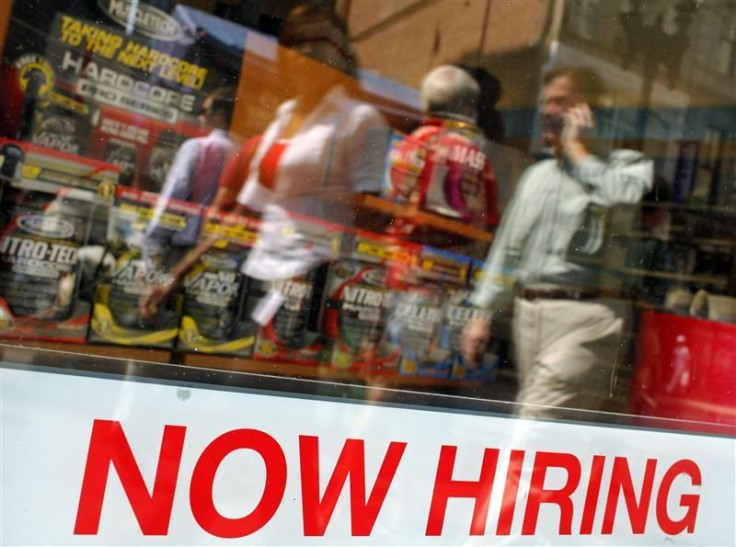Upward Revision of Payrolls Puzzles Economists

(Reuters) -- As Wall Street anxiously awaits the Labor Department's monthly employment report due on Friday, a decent bet has emerged. Odds are, the government will say it underestimated recent job gains.
The government's monthly guess on how many people draw paychecks, which sets the tone for financial markets worldwide, has been prone to upward revisions since 2009.
It is not clear what might be behind the trend, although some economists suspect the government's statistical models might be challenged when the economy is coming back from a recession.
Whatever the cause, the pattern in revisions could mean the economy is performing consistently better than data has led to believe, which makes it harder for investors and policymakers to make informed decisions.
Data that gets revised as much as it does doesn't do anybody justice, said Joseph LaVorgna, an economist at Deutsche Bank in New York who has studied the pattern of revisions.
Private sector economists have long noted that payroll estimates tend to be revised upward when the economy is growing and downward when it is not.
In the past, big revisions often have come when the government studied tax archives long after the initial data was released.
But economists have been surprised at what has become a monthly routine of revising prior job counts higher.
Philadelphia Fed economist Tom Stark focused on these initial monthly revisions in a recent research paper. Each month, the Labor Department revises the data from the prior two months based on late responses from its survey of employers.
Studying payroll data from recoveries from recessions after 1964, Stark found a statistically significant bias toward upward revisions in the current recovery for the first time since 1970.
<^^^^^^^^^^^^^^^^^^^^^^^^^^^^^^^^^^^^^^^^^^^^^^^^^^^^^^^^^
GRAPHIC- Payroll revisions http://link.reuters.com/vyj85s
^^^^^^^^^^^^^^^^^^^^^^^^^^^^^^^^^^^^^^^^^^^^^^^^^^^^^^^^^>
TARDY RESPONSES
Since the economy emerged from recession in June 2009, the government found that after tallying tardy survey responses around 36,000 more jobs were created per month, on average, than initially believed.
The question is, why would late responses inject bias into the Labor Department's initial estimate?
One possibility is that the government's model for estimating employment gains for some small businesses incorporates trends from the past. If those trends have changed for the better then more data would lead to an upward revision.
This has yet to be confirmed. But by and large, it highlights a constant hazard for statisticians who often extrapolate from the past to make sense of incomplete data.
When push comes to shove, all models are taking account of statistical correlations that are in the data of the past, said Stark, who is the assistant director of the Philadelphia Fed's Real Time Data Research Center.
So any time you have something new, you're obviously not going to be able to estimate that new thing very well, he said.
Some economists also speculate that the government's model for estimating the number of firms that are starting up or going out of business - dubbed the birth-death model - might also be challenged by the recovery.
The Labor Department, however, has also looked at revision patterns over the years and has not found evidence to indicate there is any upward or downward bias, said Kerrie Leslie, an economist at the U.S. Bureau of Labor Statistics.
Nor have government economists found evidence that tardy responses have come from particular industries that might skew the initial estimates, she said.
Still, the amount of tardy responses to the survey, which polls around 140,000 businesses, is significant.
In 2010, for example, about 70 percent of firms contacted by the government each month provided details on their payrolls at first request. Within two months of the initial survey, the percentages of responses surged to 94 percent.
The recent revisions in the payroll data have led some economists to pay extra attention to a separate - albeit smaller - survey of households that is subject to fewer changes and does not rely on a birth-death model.
In November, the household survey showed 315,000 jobs were added to the economy, while the payroll survey showed only 120,000 hires.
The household survey tends to be more volatile because it is based on a smaller sample, and many economists expect that on Friday it could show job creation slowed in December.
On the other hand, if the trend in revisions from the other survey of employers holds, revised figures for November payrolls could edge a little bit in the direction of the more positive household survey data. Analysts expect the payroll survey will show 150,000 jobs added last month.
LaVorgna expects the pattern of upward revisions to payrolls will likely continue until the economy eventually slides back into recession.
These measurement issues are significant, he said.
(Reporting by Jason Lange; Editing by James Dalgleish)
© Copyright Thomson Reuters 2024. All rights reserved.



















